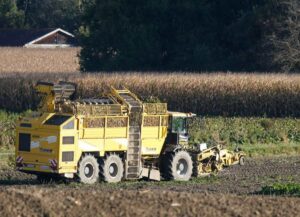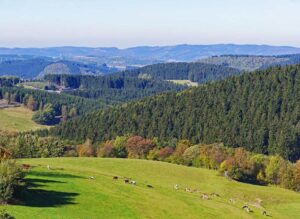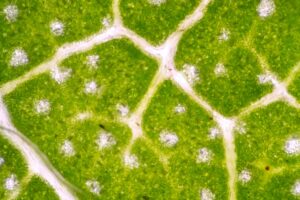Fernando Díaz
Sugar beet is a temperate climate crop grown mainly for production of sucrose. Beet pulp, the main co-product obtained during the process, is a common ingredient in dairy cow diets. Beet pulp is a good nonforage fiber source with high levels of digestible fiber and pectic substances.
According to CNCPS Feedbunk from Cornell University, fiber (NDFom), non-fiber-carbohydrates (NFC), and sugar contents in dry beet pulp are 36.8 – 41.6%, 35.4 – 40.4%, 10.0 – 13.3% of dry matter (DM), respectively. Protein concentration; however, uses to be low (10.0% DM).
A study published in Journal of Dairy Science reported the effect of replacing conventional forages (corn silage and alfalfa hay) with a combination of beet pulp and wheat straw on high-production cow performance. The beet pulp fed in this study had very high sugar content (18.6% DM; table).
| Nutrient |
Beet Pulp |
| Dry Matter (DM) % |
90.2 |
| Organic Matter (%DM) |
92.5 |
| Crude Protein (%DM) |
10.3 |
| NDF (%DM) |
35.1 |
| Lignin (%DM) |
2.1 |
| Sugar (%DM) |
18.6 |
| Starch (%DM) |
1.37 |
| NFC (%DM) |
46.5 |
| Fat (% DM) |
0.63 |
The researchers (Kahyani et al., 2019) replaced corn silage and alfalfa hay partially or totally with beet pulp and wheat straw, and fed mid-lactation cows with three different diets:
- 40% forage (18.0% alfalfa hay and 22.0% DM corn silage) plus 2.0% beet pulp in a DM basis.
- 31% forage (7.1% alfalfa hay, 12.7% corn silage, and 11.1% DM wheat straw) plus 7.6% beet pulp.
- 22.3% wheat straw as the sole forage source plus 12.4% DM beet pulp.
Protein content was similar among diets (16.1 – 16.5% DM); however, starch concentration dropped lineally (29.0, 26.8, and 23.6% DM) as the amount wheat straw increased in the diets. Similarly, forage fiber (NDF; 21.2, 19.7 and 18.8% DM) content and diet particle size (particles greater than 19 mm; 4.0, 2.2, and 0.5%) were reduced significantly.
Overall, the substitution of conventional forages with a combination of non-forage fiber and wheat straw did not affect cow performance:
- Although feeding beet pulp in combination with wheat straw as the sole forage source lowered milk yield (44.4 vs. 46.7 and 46.3 kg/day), energy-corrected-milk yield (ECM; 42.2 kg/day) was similar among diets.
- While milk fat content (3.25, 2.97, and 2.84%) and yield (1.43, 1.39, and 1.32 kg/day) increased lineally by feeding beet pulp, milk protein concentration (2.90, 2.93, and 2.94%) and production (1.28, 1.37, and 1.36 kg/day) were significantly lower in the diet with more beet pulp. The lower level of starch in this diet could have limited rumen microbial protein synthesis and decreased the supply of amino acids to the small intestine.
- Since cows receiving the diets with greater level of beet pulp consumed less DM than cows fed the other diets (24.2 vs. 25.0 kg/day), they produced milk more efficiently (1.72, 1.70, and 1.66 ECM/intake).
- Cow body weight, backfat thickness, and body reserve mobilization were unaffected by diets.
In summary, these findings suggest that beet pulp in combination with a lignified forage such as wheat straw can replace corn silage and alfalfa hay when the supply of these high-quality forages is limited.
Reference
A. Kahyani, G. R. Ghorbani, M. Alikhani, E. Ghasemi, A. Sadeghi-Sefidmazgi, and S. M. Nasrollahi. 2019. Adjusting for 30-hour undigested neutral detergent fiber in substitution of wheat straw and beet pulp for alfalfa hay and corn silage in the diet of high-producing cows. J. Dairy Sci. 102:7026–7037.







